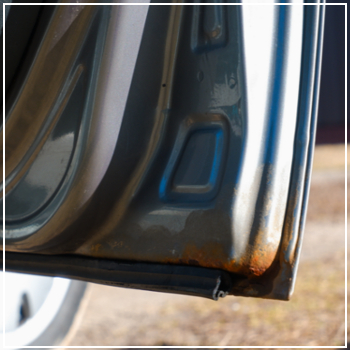Rust typically occurs when metal is exposed to moisture and salt, creating a chemical reaction that degrades the material over time. Older cars built with non-galvanized steel or traditional materials are especially vulnerable. Vehicles in coastal areas or regions with heavy snowfall face even greater risks due to increased exposure to corrosive elements. One of the most common places for rust to start is along the bottom of the car, especially after driving on salted roads during winter. However, corrosion can develop anywhere, especially where paint has chipped or peeled. It’s important to inspect your vehicle regularly and take it to a professional if you notice any signs of rust, such as bubbling or flaking paint. Here are some key areas to check: The frame rails run along the sides of your car, just beneath the doors. These parts are often made from thinner steel and are more exposed to the elements. If left untreated, rust here can spread quickly, leading to expensive repairs later on. A regular visual inspection can help catch issues early. Wheel wells are constantly exposed to road salt, water, and debris, making them a hot spot for rust. The metal used in these areas is often thin, which makes it more susceptible to corrosion. Start by doing a visual check, then run your hand along the inside to feel for any rough or uneven spots. The exhaust system, especially the tailpipe, is one of the most vulnerable parts of a car. It's constantly exposed to moisture, heat, and dirt, which can all contribute to rust. Materials like stainless steel and cold-rolled steel are not immune. Check the muffler, catalytic converter, and bends in the system—these are common trouble spots. A damaged exhaust system can affect emissions and even allow dangerous gases into the cabin. These panels sit close to the ground and are frequently hit by road debris, salt, and water. Paint chips in this area can expose the metal underneath, inviting rust to form. Keep an eye out for any discoloration or peeling paint in these spots. It’s easy to overlook the floorboards under your car’s carpeting, but rust can start there. Remove the mats and look around the insulation. Don’t forget the trunk—check the area near the spare tire for signs of moisture or corrosion. Doors can rust due to chipped paint or trapped moisture in the drain holes. Debris can also accumulate and speed up the process. Inspect both the inside and outside of each door and make sure the drain holes are clean and free of blockages. While surface rust in the engine bay may not immediately affect performance, it can still be a sign of deeper issues. If you're buying an older car, pay extra attention to components like the exhaust manifold, alternator, and strut tower. These parts are more likely to show signs of aging and wear. Modern vehicles often use plastic for inner fenders, which helps prevent rust from spreading. But the outer fender, made of sheet metal, can still rust, especially in older models. Although it's less visible, this area can trap moisture and debris, so keep an eye out for any unusual markings or flaking paint. The suspension system contains many metal parts that support your car. Rust here isn’t just unsightly—it can become a serious structural problem. Check shocks, struts, control arms, and any bolted joints. Early detection is key to avoiding costly repairs. If you're worried about rust on your vehicle, don't wait. The experts at DaSilva’s Auto Body can perform a thorough inspection and apply rustproofing treatments to protect your car before damage spreads. Contact our Naugatuck location today to learn more about how we can help keep your vehicle in top condition for years to come. Intermediate Baritone,Baritone 3 Pistons,Baritone For Students,High Quality Professional Baritone ZhengOu Musical Instruments Co.,LTD , https://www.zomusical.com Unaddressed vehicle rust can lead to serious structural issues, weakening the frame and compromising safety in case of an accident.
Unaddressed vehicle rust can lead to serious structural issues, weakening the frame and compromising safety in case of an accident.Where Does Rust Usually Begin?
Frame Rails
Wheel Wells
Exhaust System
Rocker and Quarter Panels
Floors
Doors
The Engine Bay
Fenders
Suspension